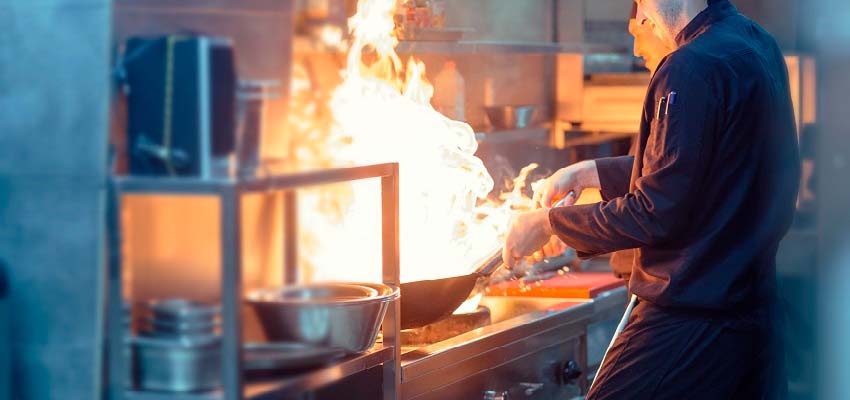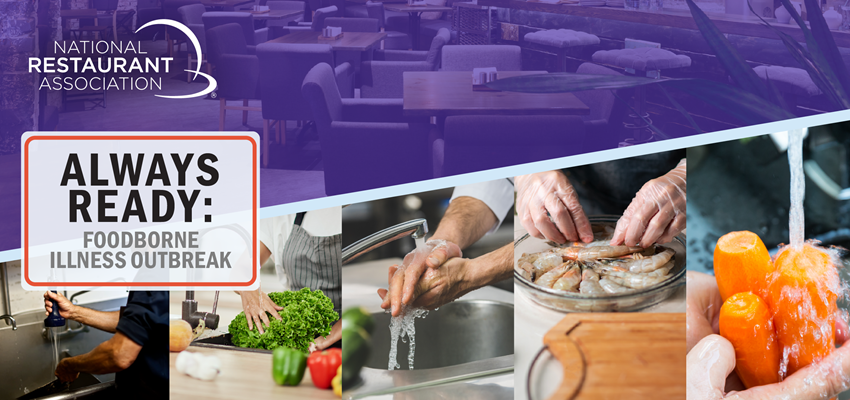Articles
September 21, 2023
Recovering from a restaurant fire
Our Always Ready: Fire guide offers tips on how to rebound quickly if fire breaks out at your operation.

In the case of a small, contained fire, a staffer can extinguish it quickly and safely by covering it with a pan lid or fire blanket.
In a commercial kitchen, fire prevention measures are critical. But if a fire does break out, follow these suggestions to help achieve a quicker rebound.
In the case of a small, contained flareup, a staffer can potentially extinguish it quickly and safely by covering it with a pan lid or fire blanket (to cut off oxygen). However, if the incident results in any food being singed or burned, the kitchen team will want to throw it out as soon as it has cooled.
A larger fire will set off most restaurants' automatic fire suppression systems and may discharge wet chemical fire retardant over the entire cooking bank. If the automatic mechanism fails, the system can be triggered with a mandatory manual pull that’s located separately.
Fire extinguishers, Class K for commercial kitchens or Class ABC for other areas, can be used after the automatic system is triggered. When wet fire-suppressing chemicals are deployed, the fire incident will require closing the restaurant and reporting it to the necessary regulatory authorities, who in turn will approve the restoration and permit reopening.
A foodservice operation that experiences a substantial fire should engage professional fire restoration services to help reopen as soon as possible.
Smoke, high heat, and fire-suppression discharge chemicals will limit what you can salvage, especially food inventory. Many food products come in packaging that won’t protect them from high heat or smoke damage. The Association of Food and Drug Officials offers a Food Salvage Guide that you can reference (see p. 76). Be sure to dispose of food products that can’t be rummaged, reused or resold by others. Request a special trash pickup if possible.
Damaged equipment will need to be replaced in the worst-case scenario, and repaired, cleaned and retested at best. Smoke damage is hard to remove and should also be left to the professionals.
Cooperate with your local regulatory agency and restoration services to recover and reopen as quickly as possible.
The National Restaurant Association has debuted the latest in its series of emergency preparedness guides, Always Ready: Fire. Free to download, the guide covers fire preparedness steps, including what to do before a fire breaks out (minimize risk, maximize protection), safety during a fire, and fire recovery efforts.
In the case of a small, contained flareup, a staffer can potentially extinguish it quickly and safely by covering it with a pan lid or fire blanket (to cut off oxygen). However, if the incident results in any food being singed or burned, the kitchen team will want to throw it out as soon as it has cooled.
A larger fire will set off most restaurants' automatic fire suppression systems and may discharge wet chemical fire retardant over the entire cooking bank. If the automatic mechanism fails, the system can be triggered with a mandatory manual pull that’s located separately.
Fire extinguishers, Class K for commercial kitchens or Class ABC for other areas, can be used after the automatic system is triggered. When wet fire-suppressing chemicals are deployed, the fire incident will require closing the restaurant and reporting it to the necessary regulatory authorities, who in turn will approve the restoration and permit reopening.
Where there’s smoke…
Fires can be the result of electrical, gas or mechanical issues, but any type of fire will generate smoke, damage from which can be very hard to eliminate. Not only is smoke capable of permeating every fibre and porous material throughout the establishment, heat from the fire can turn materials, dust, particles, and everything else in its wake into cobwebs of melted, burnt detritus that clings everywhere.A foodservice operation that experiences a substantial fire should engage professional fire restoration services to help reopen as soon as possible.
Smoke, high heat, and fire-suppression discharge chemicals will limit what you can salvage, especially food inventory. Many food products come in packaging that won’t protect them from high heat or smoke damage. The Association of Food and Drug Officials offers a Food Salvage Guide that you can reference (see p. 76). Be sure to dispose of food products that can’t be rummaged, reused or resold by others. Request a special trash pickup if possible.
Cleanup considerations
Recovering from a fire carries its own set of risks, which is why it’s best left to professionals. Potential gas leaks, smouldering debris (and the potential for flareups), hot metals, toxic air, and uneven footing are dangerous to the untrained.Damaged equipment will need to be replaced in the worst-case scenario, and repaired, cleaned and retested at best. Smoke damage is hard to remove and should also be left to the professionals.
Cooperate with your local regulatory agency and restoration services to recover and reopen as quickly as possible.
The National Restaurant Association has debuted the latest in its series of emergency preparedness guides, Always Ready: Fire. Free to download, the guide covers fire preparedness steps, including what to do before a fire breaks out (minimize risk, maximize protection), safety during a fire, and fire recovery efforts.
Download
Download

